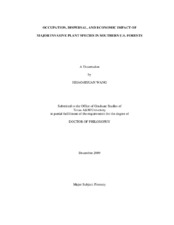| dc.description.abstract | Invasive alien plants have impacted southern U.S. forests. This study focuses on quantifying current distribution, rate of dispersals, and economic losses caused by four major invaders — Chinese tallow (Triadica sebifera (L.) Small), Chinese Privet (Ligustrum sinense Lour.), European Privet (Ligustrum vulgare L.), and Japanese Honeysuckle (Lonicera japonica Thunb.). Using data from USDA Forest Service’s Forest Inventory and Analysis (FIA), National Oceanic and Atmospheric Administration (NOAA), and USGS Land Use and Land Cover (LULC), I first used logistic regressions to build occupation models for these four species. Second, I used VB.NET© (Microsoft, 2003) and Environment System Research Institute (ESRI) Arc View® 9.2 Geographical Information System (GIS) to model spatially explicit dispersal dynamics of these species. Finally, I evaluated economic losses associated with these invasions. The results of occupation models showed that landscape features, climatic conditions, forest and site conditions, forest management activities and disturbances, and forest ownership have statistically significant impacts on current distributions of all four species. The results of dispersal models showed that invasions of Chinese tallow, Chinese and European privets, and Japanese honeysuckle will be likely to appear on approximately 6.65 million acres of forest land in East Texas and Louisiana, 3.81 million acres in Mississippi and Alabama, and 12.55 million acres in Mississippi and Alabama, respectively, during the next 20 years. The estimated timber losses resulting from the invasion with no control for the next 20 years at 5% discount rate is 518 million dollars for Chinese tallow, 2.72 billion dollars for Chinese and European privets, and 11.05 billion dollars for Japanese honeysuckle. From an economic point of view, it would be most cost effective to execute high intensity control for these invasive species. Based on these findings, strategies for monitoring and mitigating these invasive species are proposed. | en |


